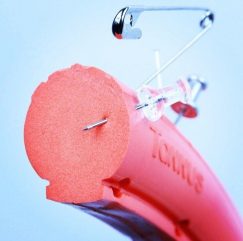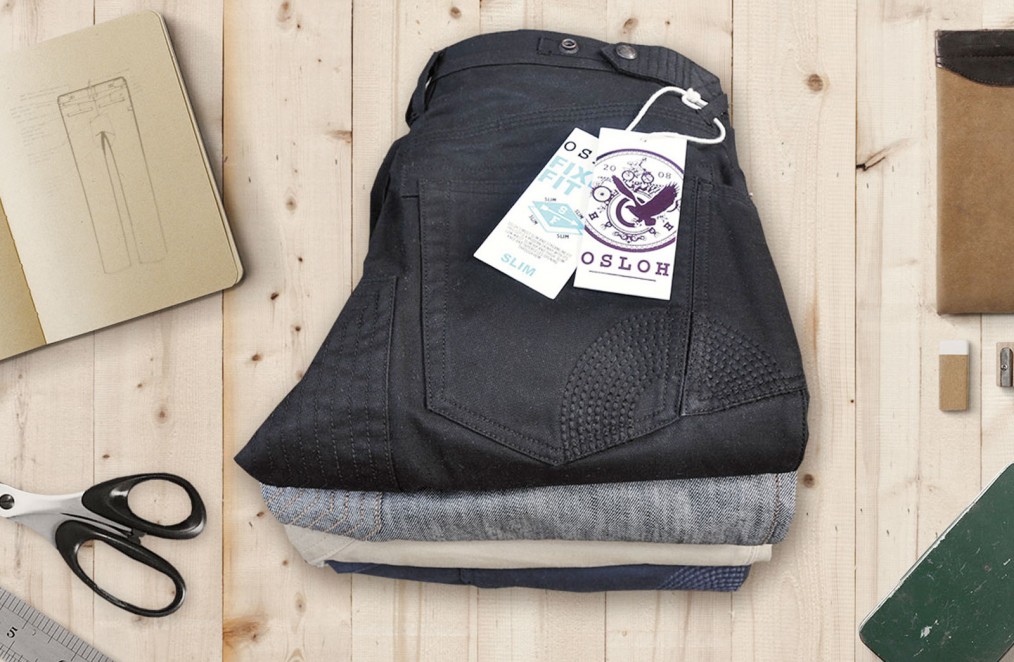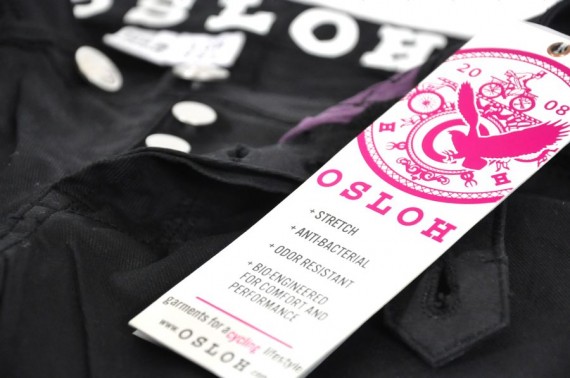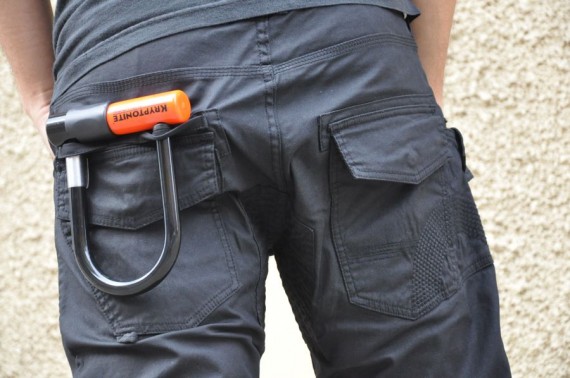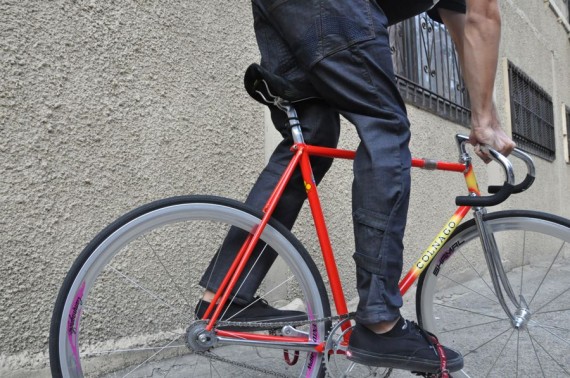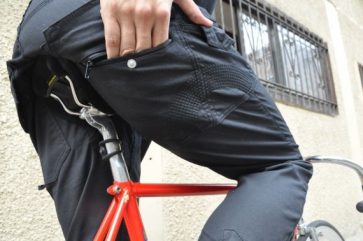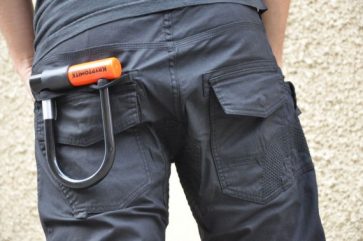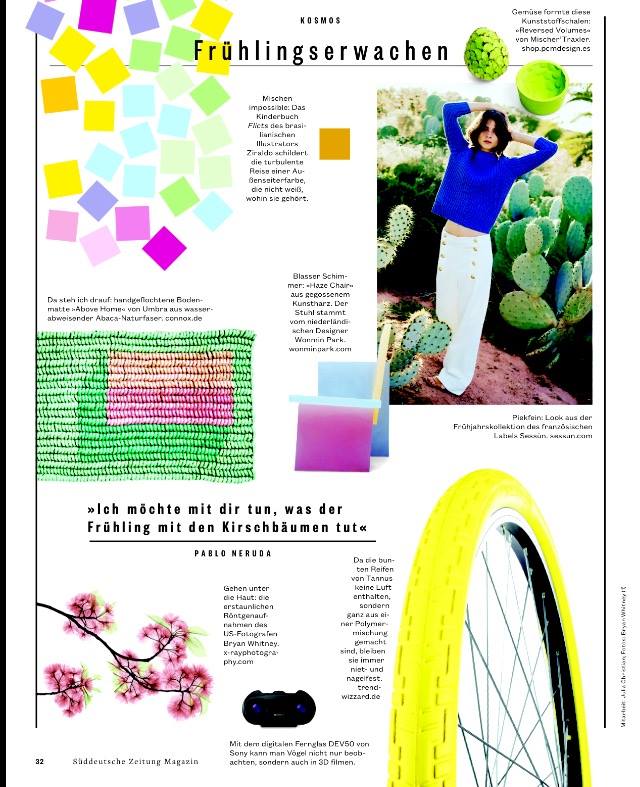tannus-solid-tyres-review
Posted by: Andrew Culture+ Posted date: December 10, 2014 In: Bike Gear News Solid tyres, why do we want them?
I’m assuming you’ve ridden a bike before? Or do you enjoy repairing punctures in the dark, in the rain, with numb fingers (with an owl!) The prospect of a bicycle tyre that is not only puncture ‘resistant’ but for which punctures are a physical impossibility surely appeals to all bike riders? If you’re commuting to work punctures make you late, if you’re riding with friends punctures make them laugh at you. Well friends either laugh or are incredibly sympathetic, without actually offering to help with repairs.
Like a lot of cyclists I made the decision to abandon traditional pumps (I hate hand-pumps SO much) for puncture repair and instead use Co2 cannisters. However, I’m always slightly scared of using Co2, it’s a fear based on the fact that while nothing is likely to go horribly wrong, there’s every chance it could spectacularly. I feel a very similar fear when standing close to a large horse. But that’s my problem.
So leaving aside for a moment the finger-numbing filthy discomfort (and potential Co2 burns / explosions) that puncture repairs cause let’s pause to consider how much kit we have to lug about in case we get a puncture. Actually let’s not, it will be dull and we all know the score – ‘a friend’ buys a bike that weighs less than a kitten’s bobble hat, then hands a heavy bag of spares from the saddle ‘just in case’.
Wouldn’t it be nice not to have to worry about punctures?
So we’ve established that there are many things in life I enjoy more than punctures, so when I was at the SPIN Urban Cycling Show in early 2014 and spotted a company called Tannus who claimed to have perfected solid tyres I really wanted to believe they had cracked the code. So after witnessing Tannus building some momentum in the UK cycling scene I got in touch with the UK representative and asked if I could take a pair for a test ride. Very kindly they said ‘yeah, go for it’. So I really wanted to love these Tannus tyres and shout their praises from the rooftops (by which I mean VeloBalls), but solid tyres have been attempted by others before, and have always failed. So why would Tannus be any different?
The problem with solid tyres
Solid tyres certainly aren’t a new idea, in fact if you want to be pedantic (and please do, we love that) then you could point out that the solid tyres pre-date pneumatic tyres (ones what have’ air in them). So why didn’t our cycling forefathers stick with solid tyres? Why on earth did they go to all the trouble of developing tyres pumped full of air? Probably because their ‘fundamentals’ were suffering from the brutal ride that solid wheels / tyres traditionally caused. So to the relief of crotches and bottoms everywhere Dunlop developed pneumatic tyres and cyclists the world over forgot about solid rubber tyres. For at least the two and a half minutes. Ever since there has been a string of companies holding up their hands and proudly stating that they have solved the conundrum of creating solid tyres that didn’t suck.
In the past ‘innovative’ solid bike tires have either weighed a ton, fallen apart, had more rolling-resistance than steam traction engine wheels coated in a metric ton of super glue or (most alarmingly of all) tended to part ways with ones rims when cornering.
But it would appear that Tannus solid tires were different, a theory I developed after realising that their popularity was growing, without the inevitable backlash of frustrations their forebearers suffered.
So with a mixture of excitement and trepidation I loaded myself and my trusty (and slightly rusty) SingleSpeed onto a train and headed for E1 Cycles in London to get me some solid tyres. Actually when I initially went to mount my steed in order to head to the station I discovered I had a puncture…
Solid tires – how are they fitted?
I had 700 x 23 tyres ‘hard’ tyres fitted.
Between getting off the train in London and arriving at E1 cycles in the East End I suffered another TWO punctures, so when the friendly staff at E1 told me the Tannus Musai tyres would be fitted in a jiffy I was about as ready as a fellow can be to shout a hearty ‘huzzah’. Instead I thanked them and wandered off in search of coffee while they got to work.
After they had taken a look at the battered old Mavic Aksium wheels on my singlespeed (someone gave them to me because they found them behind their dustbin) the only questions I was asked was ‘would I like hard or soft’, and what colour would I like? I only mention how old my wheels are in the interests of transparency – this test ride is far-removed from those carried out by the glossy magazines. I’m testing these tires on a fairly battered old bike, which I think makes the conditions closer to those experienced by the majority of VeloBalls readers. The only carbon involved in this test was the exhaust fumes I unavoidably inhaled while cycling through London.
I realise that not including details of how the tires are actually fitted is a bit an omission on my part. The chaps in the shop looked a bit confused when I asked them how difficult they were to fit. I’m not putting too much gravity on this; I’m sure any skilled cycle mechanic would give a bit of a gallic shrug if I asked how tricky it was to true a wheel or any other bit of mechanical genius that I consider magical. A friend who has fitted some Tannus Musai by himself assures me that while there is definitely a knack, fitting the tyres was certainly within the reach of us mere mortals. As I’m being so hopelessly unhelpful when it comes to details of the installation process I’m going to point you at this video:
Having watched that video a few times I’d say that unless you particularly fancy a challenge it might be an idea to get an official Tannus supplier to do the fitting for you. If you live near London then Andrés at E1 assures me that he’ll be more than happy to help.
Initial impressions
My ride from E1 to Liverpool St Station on my way home was less than a mile so my very first impressions aren’t that interesting. I arrived on Continental GP4000s tyres (well, the remains of them really) so switching to the Tannus was always going to be noticeable. But then I’m yet to find any tyre that rides as fast and comfortably as the GP4000s, but while they are fast and comfortable they do (in my experience) have as much resistance to puncturing as a balloon at a hedgehog’s birthday party.
singlespeed with solid tyres
(crap) photo of my SingleSpeed fitted with Tannus solid tyres, in a guard’s van, without an owl.
The test ride
This morning I took my SingleSpeed out for a jaunt around some of the rougher roads of Ipswich to give these tyres a proper test. The first thing that struck me was how firm the ride was; I wouldn’t go so far as to say it was harsh, but I was certainly feeling the ‘character’ of the road surface. Not unbearably so, and to be fair the harshness of the ride was not really too different to riding on fully-inflated Bontrager Hardcases.
I made a video review of the ride, you can watch it here:
Rolling resistance
When speaking to some friends who had tried previous incarnations of solid tyres (made by other manufacturers) the biggest complaint they had was rolling resistance. This meant that more effort had to be put into shoving the bicycle forward than with inflatable tyres. I wasn’t expecting the Tannus tyres to be entirely free of rolling resistance (no tyres ever are) but I was surprised at just how little they had. I’m not an expert in such things, but other (far cleverer) websites somehow figure the rolling resistance is 8% higher than with standard tyres (whatever ‘standard’ tyres are!).
Overall grip and control
Horror stories from the history of solid bike tyres include tales of slippage in some very alarming ways. Previous incarnations of non-pneumatic tyres didn’t hold the road very well, meaning that cornering, not just at speed, but at all, could be much more of an adventure than any cyclist would seek out. Sure most of us like taking risks on bikes, but they’re usually risks whereby you have a good idea of the risk you’re taking, and mechanical sympathy (taking the form of good maintenance) helps mitigate that risk. Going around a corner and having the tyres slip out from underneath you because the tyres aren’t gripping the road is a risk that can only be mitigated by changing tires (or not cycling in sub-zero conditions!). The road conditions for today’s test ride was most unfavourable – it has rained recently and the general December weather has made the roads greasy and coated with a layer of grit and detritus that can cause an unscheduled dismount for inexperienced riders. Despite the fact I was riding with a suitable amount of caution I was being far from cavalier, and I felt totally in control with these Tannus tyres.
Perhaps more alarming than ones bike parting company with oneself on a corner is having a tyre that isn’t securely fastened to the rim. There are reports by the owners of ye olde solid tyres of yesteryear that tell of occasions when they had to brake hard, only to have the wheel stop, but the tyre carry on turning! Fortunately I didn’t have to slam on the anchors for an emergency stop on my test ride, but having just watched that fitting video again I’m confident enough that if I did hit the brakes I’d stand a pretty good chance of stopping.
In the interests of addressing as many of the ‘old complaints’ as possible I’m going to mention one last control nightmare – losing the tyre entirely. Yup, in the the distant past some cyclists (riding other brands of solid tyre) have come a cropper when their tyres have popped out of the rim while they’re cycling! I’m no expert, just ‘some bloke with a crap bike’ but I’m not worried that these tires will leap out of rims. Quite the opposite; I’m not sure I’ll ever be able to remove them! Good job – the manufacturer claims they last about 9,000 miles.
Weight
The tyres I had fitted weigh near as dammit exactly the same amount as Bonrager Hardcases, once you take into account the tube. Impressive. The low weight is probably due to the fact these tyres aren’t made of rubber at all, in fact they’re made from a type of foam, er, sort of, that Tannus call ‘Aither’.
Price
No getting around it, these Tannus tyres ain’t cheap. You could almost buy four of the (almost) bombproof Schwalbe Marathon Plus puncture resistant tyres for the price of two Tannus Musai. I’ve been using Bontrager Hardcase tyres on my bikes for a few years, and despite the fact they’re not the most comfortable tyre in the world, I could buy six or seven for the same amount as a couple of pairs of these solid tyres. But according to the official stats the Musai tyres should outlive the competitors tyres many times over.
I’m intrigued with regards to the price Tannus has set for this product – if a company is introducing a radical new product to a sceptical market (and cyclists are notoriously sceptical) then there’s a big temptation to sell at a narrow profit-margin to get the product established. At the other end of the scale is companies like Apple who set their prices high and sort of impress and wow the market by claiming the high price is because their output should be considered as premium product. I have no idea how much profit Tannus makes on each tyre, but knowing a little bit about manufacturing processes (ha, I really do!) I wouldn’t expect the cost per unit to be exceptionally high. However, the high price could well reflect the research costs Tannus have incurred in the 25 years they have been researching the materials used in these tyres. It’s worth noting that tyres aren’t the only product Tannus make, among a wide product range are some extremely safety-aware products like the padding used inside American Football helmets.
I’m digressing, and I’m resorting to pointless conjecture – let’s get to the summary!
Summary
Solid tyres are more than just not getting punctures, they’re about not having to check tyre pressures, making your bike ready to go with zero preparation. If you are a regular commuter preparation is no big deal, checking tyre pressures is as much a part of your routine as making your packed lunch, or packing dry underpants in case of severe rain. But when I want to jump on my bike to nip into town not having to check the tyres for either pressure or punctures is pretty cool.
It seems a little foolish to claim to be able to make a solid-gold summary after just one ride, so sorry if you’ve just read through all of the above 2,500+ words and were expecting a definitive answer. I can only give you one man’s subjective opinion, which I guess all reviews are really, but here’s how I now view Tannus Musai tyres and how they fit into my cycling life (I’ll try and keep this brief, honestly):
Solid tyres on my singlespeed
I never use my SingleSpeed for any journey longer than ten miles, partly because of the stupid 52/18 ratio I have, but also because if I’m going on a ‘leisure bimble’ I’d much rather use gears. So for all the journeys I make on the bike I have these tires fitted to I’m quite happy to put up with a slightly bumpier ride than I’m used to, I consider that a very small price to pay for not having to fix any punctures. To be fair I’ve had very few punctures with the Bontrager Hardcases I’ve been riding, but no punctures is a much more exciting prospect than ‘very few’ punctures.
Every cyclist has to make compromises with their equipment in some way, even a rider with a limitless budget will forced to make a compromise at some point. The ride-comfort concession when using solid tyres is so miniscule it seems pretty much a no-brainer.
Solid tyres on a lightweight bike
Okay, so I’m fooling myself a bit here, my aluminium framed geared bike is no featherweight at about 11kg, but I wanted a clear way to differentiate between my commuting ‘getting around town’ bike and the bike I use for longer rides and sportives. So will I be rushing out to buy a pair of solid tyres for my ‘nice’ bike? Hmm, probably not. For now I’m going to stick with using the Bontrager Hardshells as my winter tyres – when I’m using gears on a long ride that tiny amount of extra rolling resistance the Musai give could start to feel like a lot of extra rolling resistance after fifty or sixty miles. That being said, I’m not ruling it out entirely. It could only take a couple of roadside puncture repairs in freezing conditions to make me consider putting solid tyres on my lightweight bike a lot more favourably. But will I ever use solid tyres in place of my favourite summer tyres? I very much doubt it.
The real summary
I’m really looking forward to the next time I take my SingleSpeed to London; I’m going to be wearing a big smile on my face knowing that I’ll be able to ride those awful, pitted, violently undulating glass-strewn roads with total impunity from the puncture fairy.
Where to buy Tannus tyres
As always we’d recommend making your local bike shop your first stop in any serious search for bike gear, but if they don’t stock these solid tyres here are some other places you can buy them: www.trendwizzard.de

